
Download the PDF of this article
When a spaceship crash landed in a day nursery’s grounds, the children were inspired to go on an out-of-this-world mission to investigate the site, rescue an alien and send him back to space.
Staff at Treetops Nursery Alton Manor in Belper, Derbyshire – part of the Busy Bees group – were challenged by their regional manager to plan a science, technology, engineering and mathematics (STEM) focus. Children had been showing an interest in aliens and space-related activities after sharing The Way Back Home by Oliver Jeffers and Beegu by Alexis Deacon, so staff felt developing this area would be ideal.
‘We want to cultivate the children’s interest in STEM subjects because these areas are becoming increasingly important in the workforce,’ says nursery manager Stefanie Reardon.
‘We have a lot of girls in our pre-school. Women are under-represented within the workforce of STEM, and research shows that this number could be massively increased if girls in the early years were given encouragement to spark passion and enter this field, so one of our outcomes of this adventure was to encourage girls to really get involved.’
She appointed two Level 3 staff as nursery STEM co-ordinators to plan six focused days and also look at how STEM could be introduced into the nursery on a day-to-day basis. The nursery also wrote to parents explaining the importance of STEM and what they had planned for the week so they could speak to their children and support their interests and learning at home. Parents could also track the events on Facebook and Twitter.
DAY 1
The adventure began one Friday with the arrival of fire-fighters, who wanted to check the nursery roof as there had been reports of spaceships in the area. They couldn’t find any evidence of alien life but were happy to take the opportunity to show the children the tools and equipment that they use for their work.
After they left, the children were fascinated to watch what was happening in the sky. They identified the tracks of aeroplanes, listened to what they thought was a helicopter, marvelled at the different cloud formations and started to wonder about space. Staff provided books and resources on space to support their interest and some children used the mark-making area to draw spaceships.
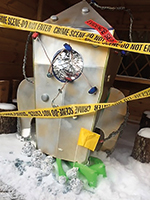 DAY 2
DAY 2
‘It had snowed over the weekend and a couple of children came to my office to tell me that they’d looked through the windows and seen something unusual in the grounds,’ says Ms Reardon. What they could see was a shiny ‘spaceship’ – made from a large box painted with metallic paint, with a range of nuts, bolts and wires inside and finished off with flashing bicycle lights. The spaceship had crashed, marking a runway in the snow as it slid to a halt.
Initially, the children were hesitant about approaching the spaceship, preferring to peer at it through the windows. Some made observational drawings.
DAY 3
The next morning, children arrived at nursery eager to see if the spaceship was still in their grounds. They were interested to return to books they had read about aliens and were thrilled when police officers arrived to secure the crash scene and talk to the children about scientific investigation. They brought evidence bags and forensic finger-printing kits.
When the children approached the spaceship with the police, they found a green alien underneath. ‘They were very concerned about the alien but couldn’t move the spaceship because it was too heavy,’ says Ms Reardon.
This sparked lots of problem-solving about how to move it and how to return the spaceship and the alien back to the mother ship.
DAY 4
‘We had planned for the children’s STEM learning but hadn’t predicted the social skills that many of the children would develop as they cared for the alien,’ says Ms Reardon. ‘Many children talked about the alien’s feelings, that it must be lonely because it was lost. They discussed what aliens look like and questioned what an alien is.’
A child said the alien might be hungry, so they chatted to the nursery cook about what aliens might eat and went on to research astronaut food on the internet.
Some children queried whether it was a real alien under the spaceship and were fascinated with looking at each other’s fingerprints and whether the alien had fingerprints too. Children revisited the crash scene to check on the alien and collect evidence. They examined green ‘alien slime’ – made from cornflour, water and food colouring – and used the police evidence bags to collect it.
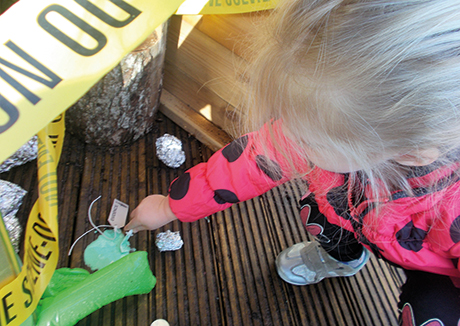
Children got out their tools to try to fix the spaceship and called on the nursery’s maintenance man to help, but they didn’t manage to get it working. However, he did have a variety of blueprints of spaceships that he put on the nursery lightbox to examine with the children and discuss how spaceships are built.
DAY 5
Children continued to think about how they could get the spaceship to fly. This led to floating and sinking experiments and discussions about the weight of different objects and how vehicles are powered. They compared a remote-control battery-powered car with one propelled by a balloon. Children also had a go at making their own rocket fuel by mixing vinegar with soda powder and watching it bubble, but it was decided that it didn’t have enough force to get the spaceship off the ground. A water rocket launcher was mentioned, before a child suggested using helium balloons.
DAY 6
The children attended nursery dressed as scientists, aliens and astronauts for the big day when they would try to help their new alien friend return home. Sadly, they decided that the spaceship was too heavy for them to send back to space with helium balloons, but they weighed the alien and decided how many balloons to attach to it.
‘The children did a countdown and the alien was launched. It was a bit hairy at first but eventually it floated off,’ recalls Ms Reardon. ‘It was beautiful seeing the children all looking up into the sky and waving – NASA would have been proud.’
And finally…
Weeks later, the children still talk about the alien, wondering how it is and whether it got home safely. In reality, a staff member retrieved the alien and balloons from the local park to avoid harming the environment. Ms Reardon feels the children need to have a conclusion and is considering having the alien send them a letter, which could lead to more explorations.
BOOK CORNER
 Beegu
Beegu
by Alexis Deacon
Friendly Beegu is lost on Earth and the Earth People don’t seem very welcoming. However, so far she’s only met the big ones. Will the little ones help her?
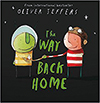 The Way Back Home
The Way Back Home
by Oliver Jeffers
A boy finds an aeroplane in his cupboard and decides to try it out. He’s flying high until, suddenly, it splutters and runs out of petrol. Now he is stuck on the moon and he’s not alone.
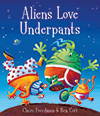 Aliens Love Underpants
Aliens Love Underpants
by Claire Freedman
‘Aliens love underpants, in every shape and size, But there are no underpants in space, so here’s a big surprise…’ This funny tale with silly rhyming text will appeal to all ages.
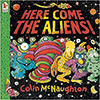 Here Come the Aliens!
Here Come the Aliens!
by Colin McNaughton
Explore planet Earth and all its secrets in rhyme. ‘They come from planets near and far – some big, some small, some quite bizarre.’ Moving at the speed of light and looking for a fight, the aliens are back, but this time they’re coming to Earth to conquer the human race!
 Man on the Moon
Man on the Moon
by Simon Bartram
Bob – everyone’s favourite man on the moon – keeps the moon clean and entertains passing space tourists as well as giving guided tours. He knows everything about the moon and that there is definitely no such thing as aliens! Look out for his other adventures, includingBob’s Best Ever Friend.
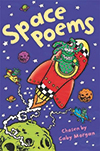 Space Poems
Space Poems
by Gaby Morgan
Blast off into space with this collection of poems about stars, rockets, astronauts, UFOs, aliens, black holes, space pets…
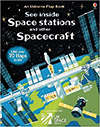 See Inside Space Stations and other Spacecraft
See Inside Space Stations and other Spacecraft
This lift-the-flap book, published in association with the UK Space Agency, takes readers on a mission inside extraordinary space stations and spacecraft. It tracks from the beginning of the space race to the latest missions to Mars and beyond.









